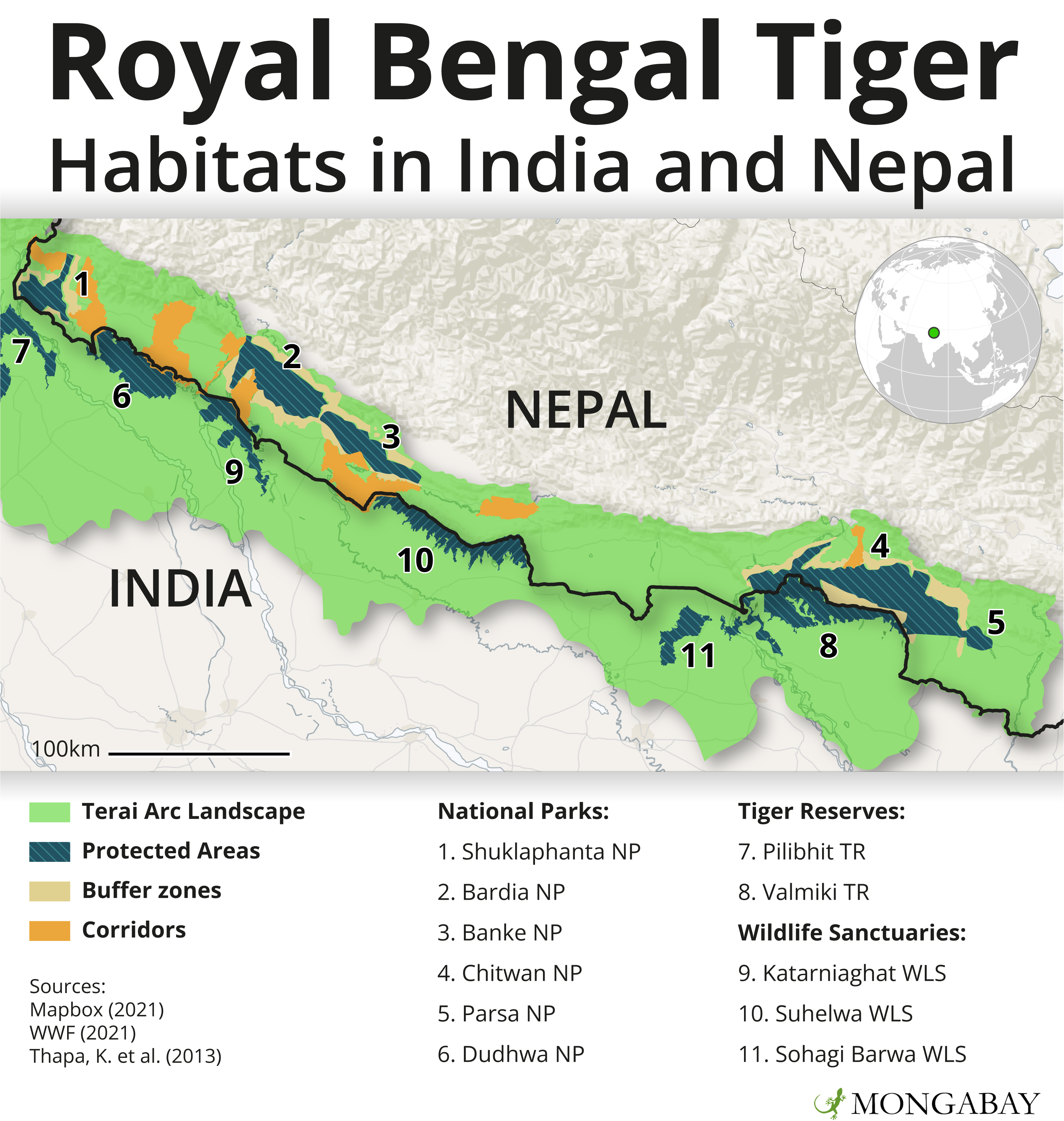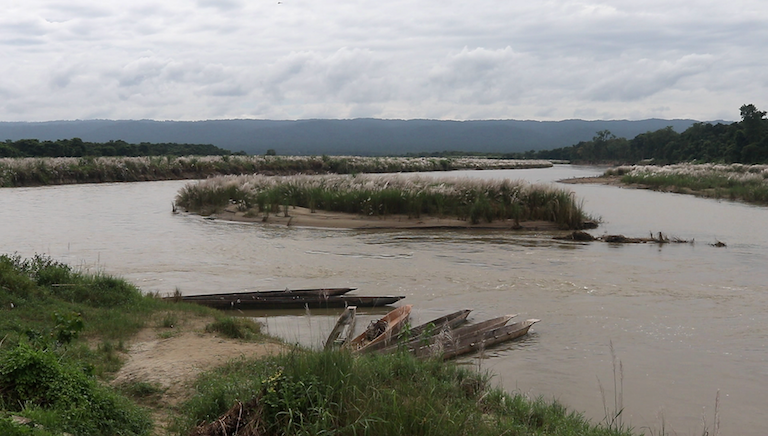- Nepal is expected to announce a much-anticipated doubling of its tiger population to 250 of the big cats from 12 years ago, on International Tiger Day (July 29).
- But critics say the country’s singular focus on increasing the tiger population has overlooked the impacts on communities living near national parks and wildlife reserves, who have suffered an increase in human-tiger encounters.
- They say the country has exceeded the population of tigers that it can comfortably accommodate, even as the government says it has room for up to 400 of the big cats.
- Officials say there are various options to address a tiger surplus, including housing “problem tigers” in zoos, gifting the animals to foreign governments as a form of diplomacy, and, as a last resort, culling the cats.
KATHMANDU — As the world prepares to mark International Tiger Day on July 29, officials in Nepal are putting the finishing touches on a report that’s expected to show a much-anticipated doubling in the population of the big cats in the Himalayan country since 2010.
Nepal is one of 13 tiger range countries, and the only one realistically expected to achieve the goal set 12 years earlier at the inaugural Tiger Summit in Saint Petersburg, Russia, to double the global tiger population by 2022. The country was home to 121 Bengal tigers (Panthera tigris) in 2010, and by 2018 already counted 235 of the endangered cats — well on its way to exceeding its target of 250 by this year.
“We are preparing to make the number public on July 29 on the occasion of Global Tiger Day,” Ganesh Pant, an ecologist at Nepal’s Department of National Parks and Wildlife Conservation, told Mongabay.

Officials say that when the final tally is announced, they’re confident of hitting the target, referred to as TX2 (“tiger times two”). And even if it’s short of the odd tiger or two, it won’t be that far off the goal, officials involved in the latest census told Mongabay.
But Nepal’s success in tiger conservation has fueled a debate over how many of the apex predators are too many for the country, and possible measures to control their population when it inevitably exceeds the capacity of Nepal’s national parks and wildlife reserves to house them. While officials say that’s something to address in the distant future, local community leaders say they believe Nepal may have already hit its peak tiger moment.
“Our studies indicate that Nepal can accommodate up to 400 tigers,” Pant said, citing a 2020 study by the wildlife conservation department in the Chitwan-Parsa complex, a key habitat for the animal. “We are still far off from that number.”
As part of the study, researchers estimated that an average tiger needs 2,000 kilograms (4,400 pounds) of meat a year. Using this figure, they concluded that Chitwan National Park, which now has 93 tigers, can accommodate 136 tigers. Further extrapolating the study to habitats in Bardiya National Park and Shuklaphanta Wildlife Reserve, officials came up with the figure of 400 tigers as a rough estimate of the carrying capacity for the whole country.

But critics point out that the study only looked at prey numbers in Chitwan and the size of its grasslands to arrive at the figure. They say the study ignored the key issue of increased human-tiger interactions in recent years.
“Indigenous people and the communities living close to tiger habitats are paying the price of conservation [success] with their lives,” Birendra Mahato, director of the Tharu Cultural Museum and Research Center in Sauraha near Chitwan National Park, told Mongabay.
“Government studies on carrying capacity don’t take this into account,” he added. “Personally, looking at the social and environmental situation in Chitwan, I believe that we already hit carrying capacity back in 2018.”
Three people were killed on average every month in encounters with tigers during the last fiscal year, which ended in July, according to government figures. At the same time, government facilities to hold “problem tigers” have run out of space as an increasing number of tigers are brought in after being involved in conflict with humans.

Mahato said he’s concerned that given the limited habitat that the species has on Nepal’s plains and the looming threat of climate change, tigers could start moving north to higher altitudes, where decades of outmigration have left vast swaths of land fallow.
“Various studies already show that tigers are moving up due to climate change, and this could lead to increased conflicts in new habitats,” Mahato said.
But authorities say this scenario is highly unlikely as there are natural limiting factors to population growth. The population growth rate will taper off in the future in line with limits on the availability of food and territory, Pant said.
Maheshwor Dhakal, former chief warden of Chitwan National Park, said that instead of worrying too much about the carrying capacity, officials should focus on improving the habitat of tigers and empowering local communities to benefit from conservation.
“The first thing that needs to be addressed is the quality of habitat,” he told Mongabay. “Then, we need to urgently address the issues of human-wildlife conflict, poaching and illegal trade, threat of invasive alien plant species, climate-induced disaster, management of prey base, development of infrastructure, employment of local people in tourism, and mobilization of security forces.”
Dhakal said carrying capacity can be a tricky number to calculate as tigers are known to thrive even in small areas. He cited the example of Jim Corbett National Park in neighboring India, where 231 tigers live in a core habitat of 521 square kilometers (201 square miles). The 93 Chitwan tigers, by contrast, enjoy a much more spacious core habitat of 952 km2 (368 mi2).
Achieving the TX2 goal (or even just getting within striking distance of it) will be an important moment to reflect on the successes and shortcomings of the tiger conservation program in Nepal, Pant said. He added that officials have identified key areas that need to be addressed under a new tiger action plan.
“The focus is now on reducing human-tiger conflict and helping local communities reap direct economic benefits of conservation,” he said.
In the event that the tiger population needs to be controlled, however, officials don’t yet have a clear plan of action, as the focus has always been on growing the population.

“There are certain measures that we could explore,” Pant said. “For example, aged tigers that live on the fringes of protected areas are often involved in conflict with humans. They could be translocated to different zoos across the country.”
Tigers could also be gifted to foreign governments and zoos, in exchange for other species or funding for conservation efforts in Nepal, Dhakal said, calling this “tiger diplomacy.”
If officials run out of options, then “problem tigers” might need to be culled, Pant said.
Animal rights activists have balked at the suggestion. They say that increasing tiger numbers to suit the agenda of certain wildlife NGOs without considering the impacts on local communities has always been problematic.
“How can a group of leaders meeting in a big country decide how many tigers people in Chitwan or Bardiya will have to live with?” Shristi Singh Shrestha, an activist with the Jane Goodall Institute Nepal, told Mongabay. “The idea of translocating tigers doesn’t even match the conservation ethos.
“Officials who blindly advocated to increase the population of tigers without considering its impacts on local communities need to be held accountable for their actions,” she added.
Banner Image: Bengal tigers at the Central Zoo in Lalitpur, Nepal. Image by S Pakhrin/ CC BY 2.0
Feedback: Use this form to send a message to the author of this post. If you want to post a public comment, you can do that at the bottom of the page.
